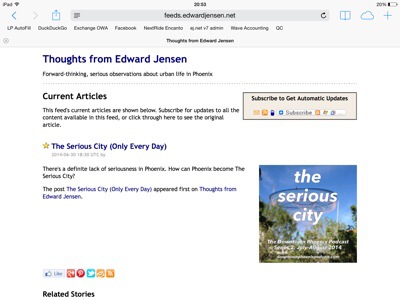 It’s been a considerable time since I’ve last posted – 427 days to be exact. That won’t happen again. Anyway, here are five of the many things that have been on my mind in the last sixty-one weeks and will be the focus of the next few additions to this blog…
It’s been a considerable time since I’ve last posted – 427 days to be exact. That won’t happen again. Anyway, here are five of the many things that have been on my mind in the last sixty-one weeks and will be the focus of the next few additions to this blog…
1. Still thinking about Chromebooks. This one’s fitting since my last post was about Chromebooks and how I’ve been playing around with them. In the intervening fourteen months, I’ve been off-and-on with mine but I’m still using it. It’s amazing to see how much it’s matured over that time period and how well it plays with Windows infrastructure via a Google-provided SMB share connector or a third-party RDP app. VPN connectivity is interesting with it but that’ll be the subject of a future post.
2. HOAs and IT. One of the big projects I’ve been tackling lately is the IT needs for a midrise condominium complex in midtown Phoenix. This will certainly be the focus of many posts down the road for sure; in the meantime, one theme that’s quickly emerged is that communicating technical issues and needs in non-technical terms is a skill that IT leaders need to embrace.
3. Midtown Phoenix. In 2016, I became disillusioned with the state of downtown-centric advocacy organizations and made a conscious decision to focus on the part of the world where I live and work: Midtown. As a means to that end, I’ve been elected to the board of the Midtown Neighborhood Association. August 2017 will mark the 17th anniversary of when I started to observe Midtown and the 11th anniversary of moving here from the suburbs. This renewed Midtown-centric advocacy focus is part of my love letter to Midtown.
4. Fifth-largest city. The big thing that’s got Phoenix “thought leaders” excited is the news that’s come around that the City of Phoenix proper is now the fifth largest city by population, overtaking Philadelphia, Pennsylvania. How many square miles of desert have we sprawled into to accomplish this “feat”? I mean, where do we collect our prize? What is our prize? Meanwhile, central-city Phoenix continues to suffer and the policy shifts from both Washington, D.C., and our own State Capitol won’t help that cause.
5. The Downtown Phoenix Podcast. I know there have been a few false starts of the resuming of The Downtown Phoenix Podcast and that’s frustrated me. This is a project that needs to happen to bring serious conversation to the issues facing central-city Phoenix. I think I’ve identified a couple new individuals who will help in bringing this back. Stay tuned.
 Earlier this week,
Earlier this week,  If you thought you heard a familiar voice on
If you thought you heard a familiar voice on 

 I’m creating a new statistic here: the “Eddie Number.”
I’m creating a new statistic here: the “Eddie Number.”
